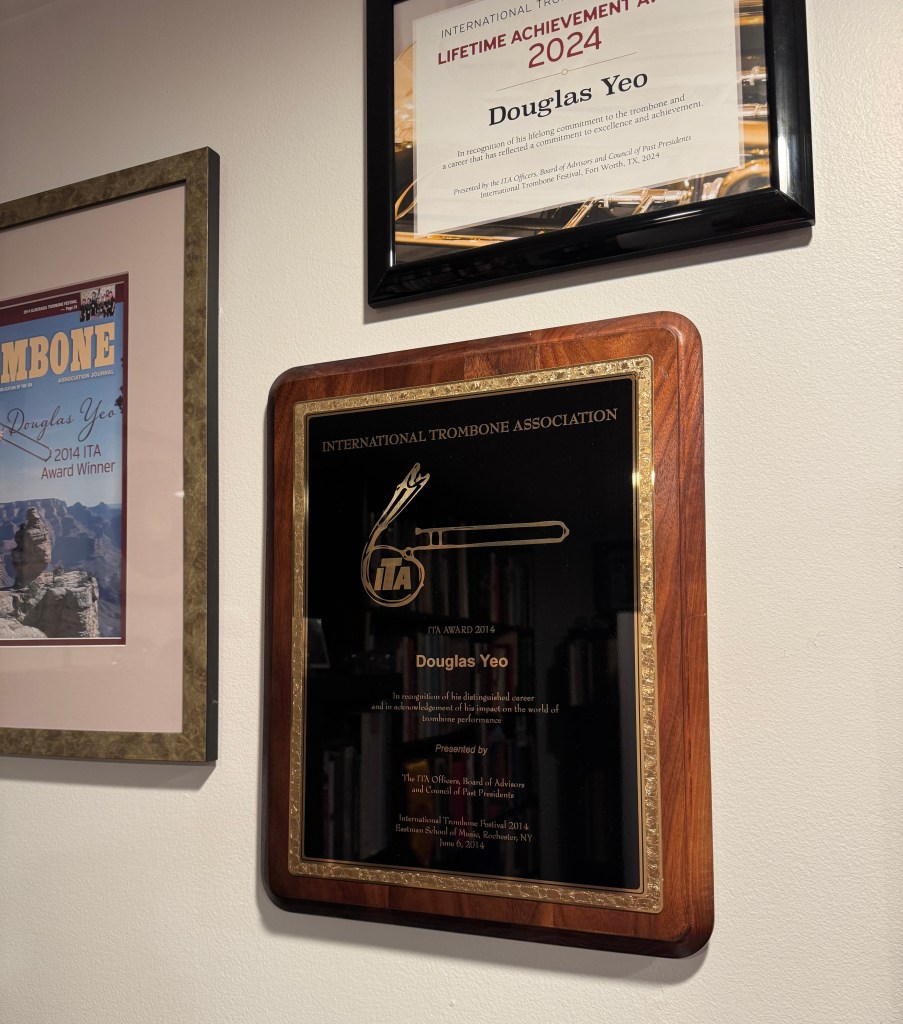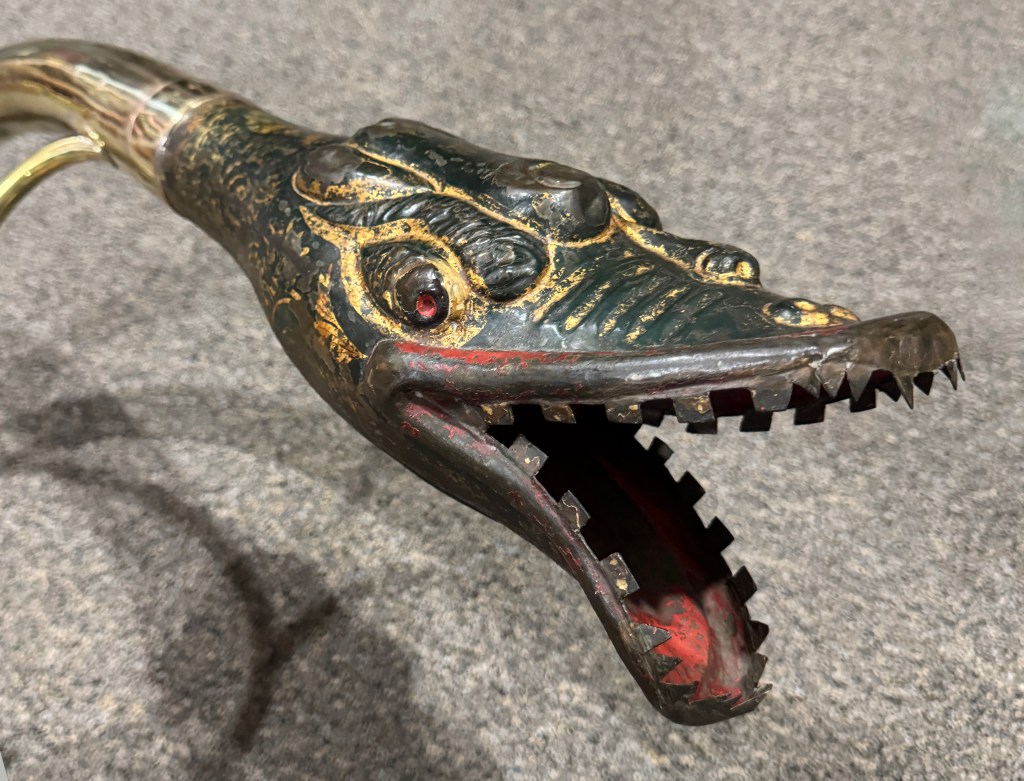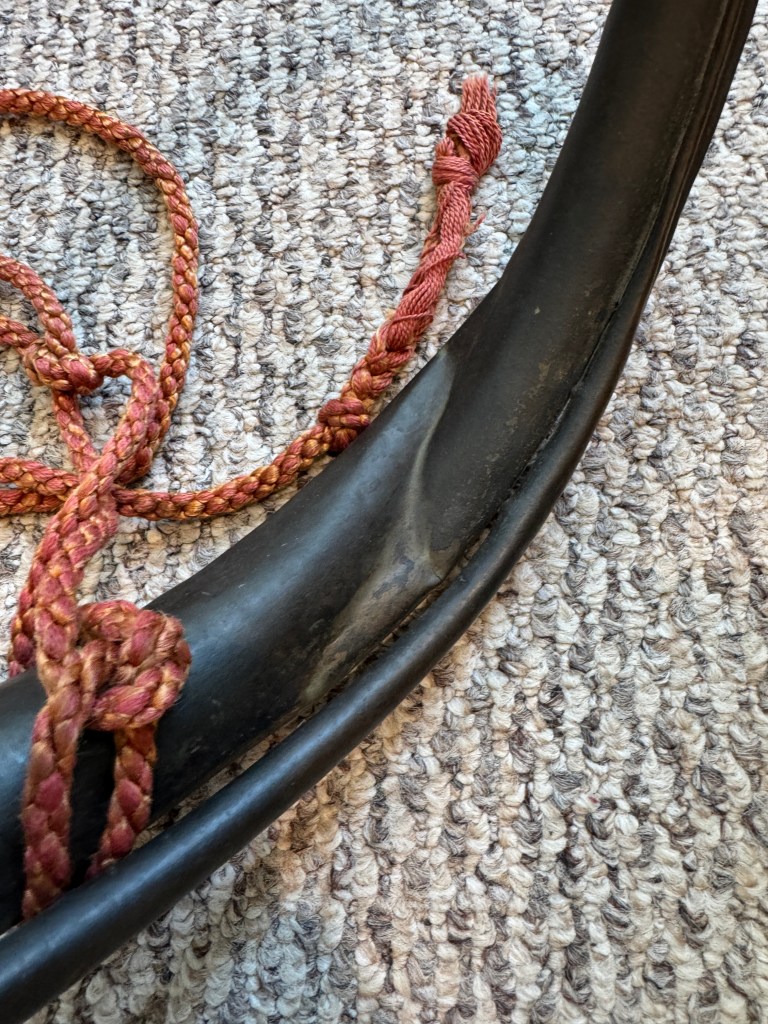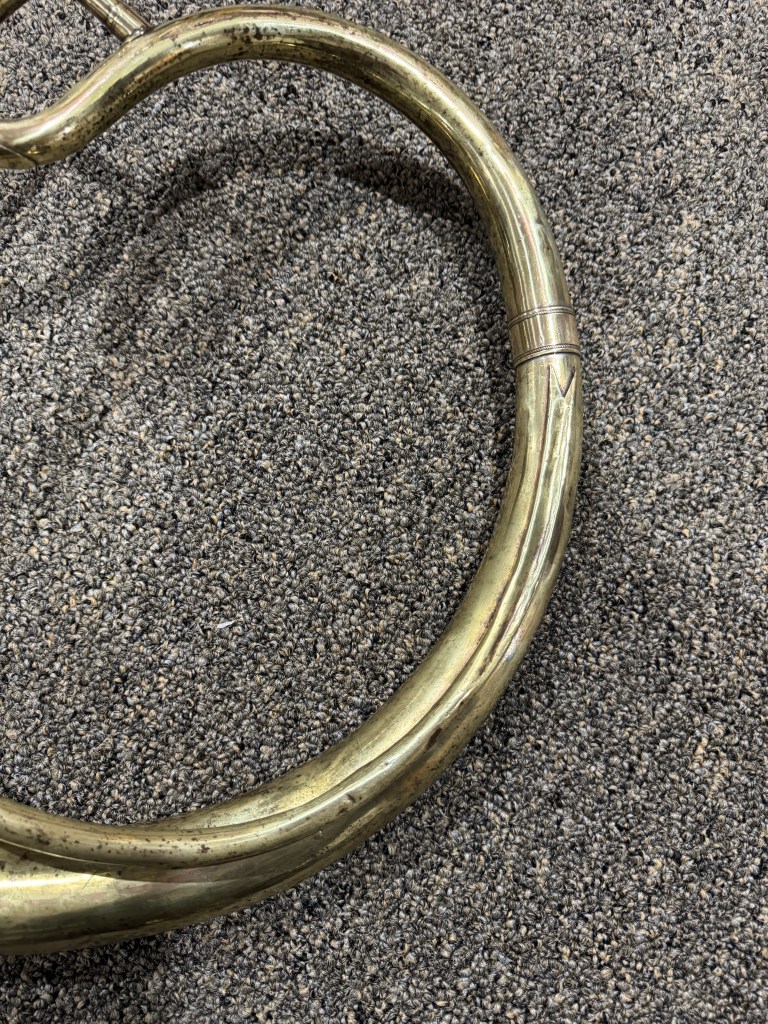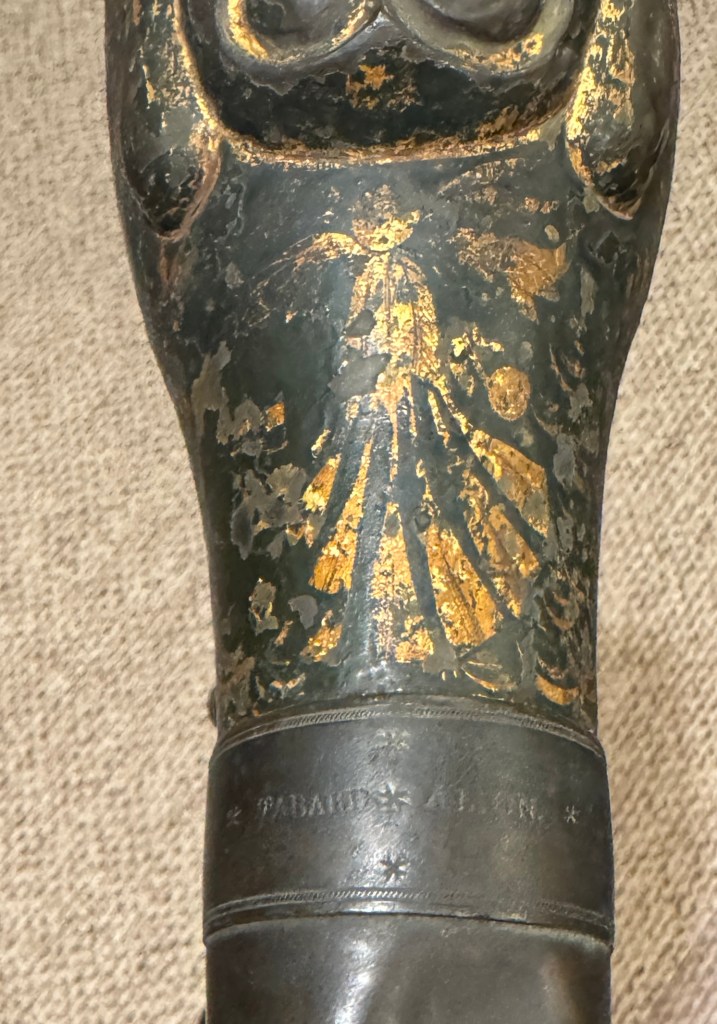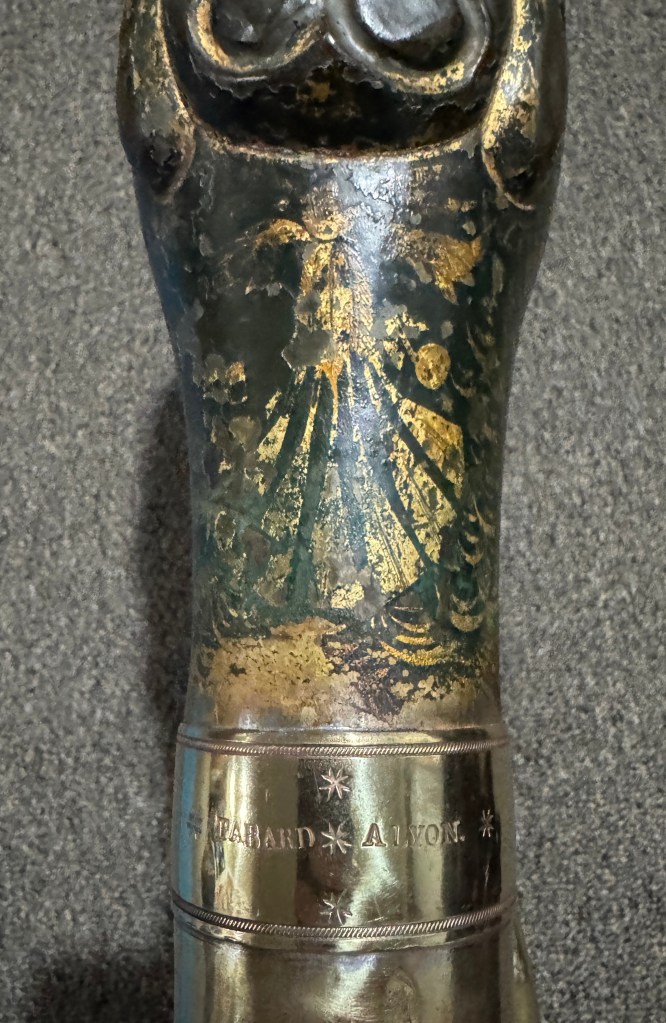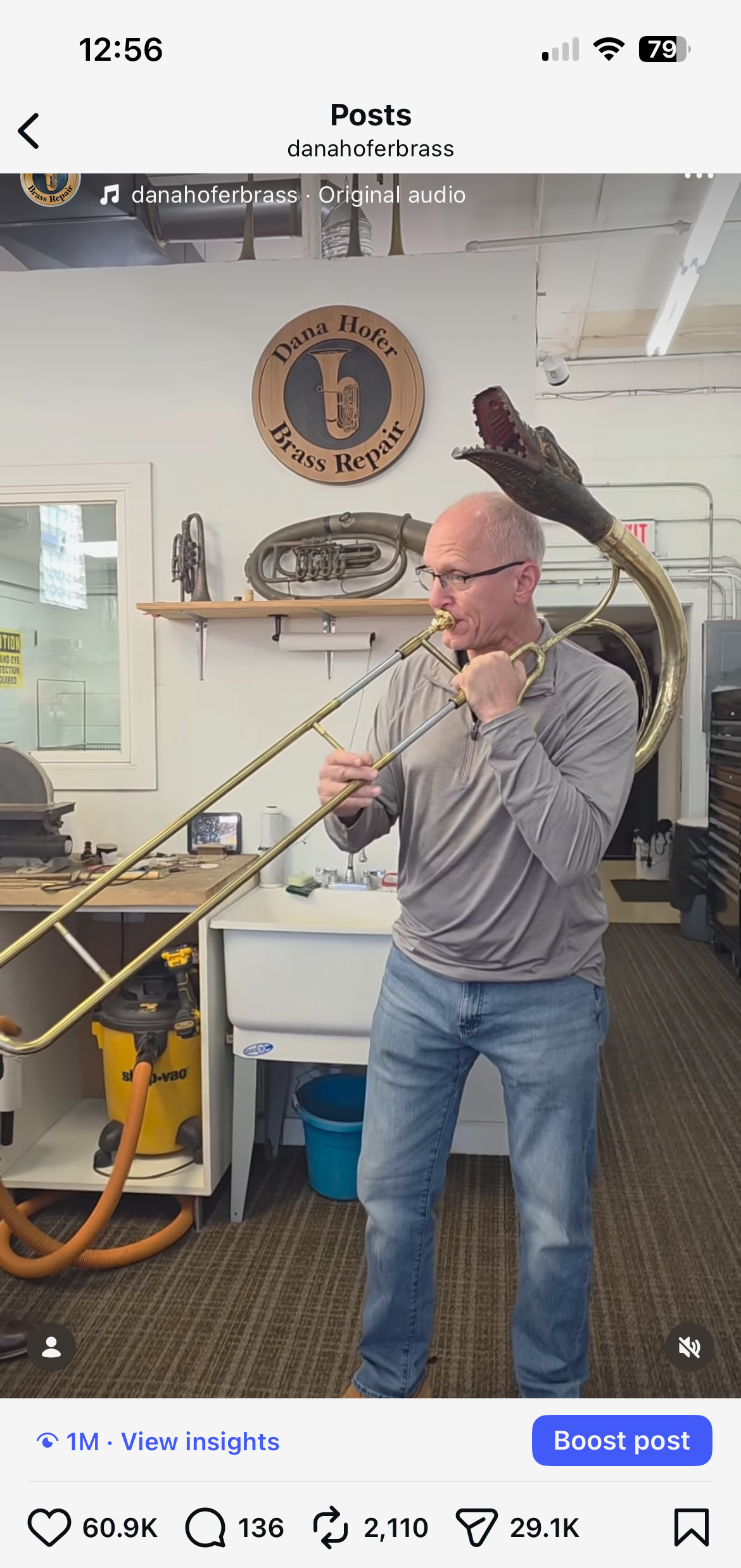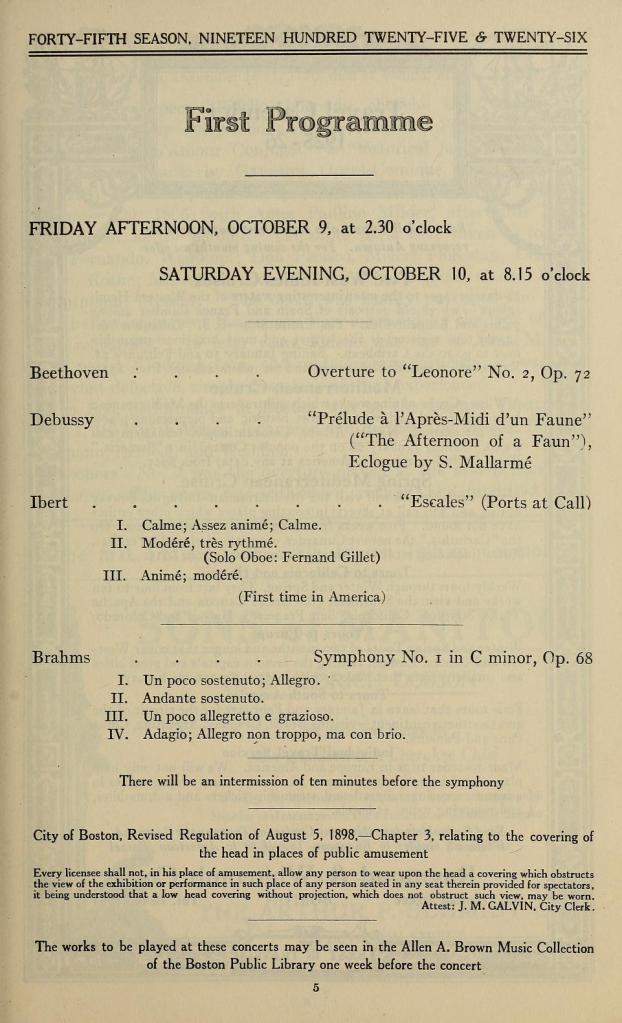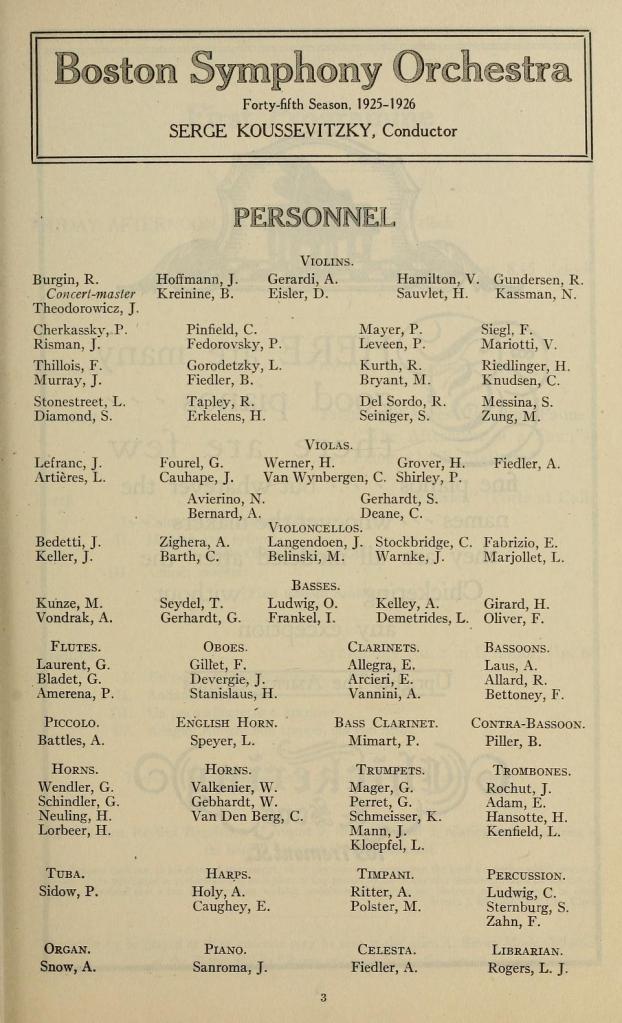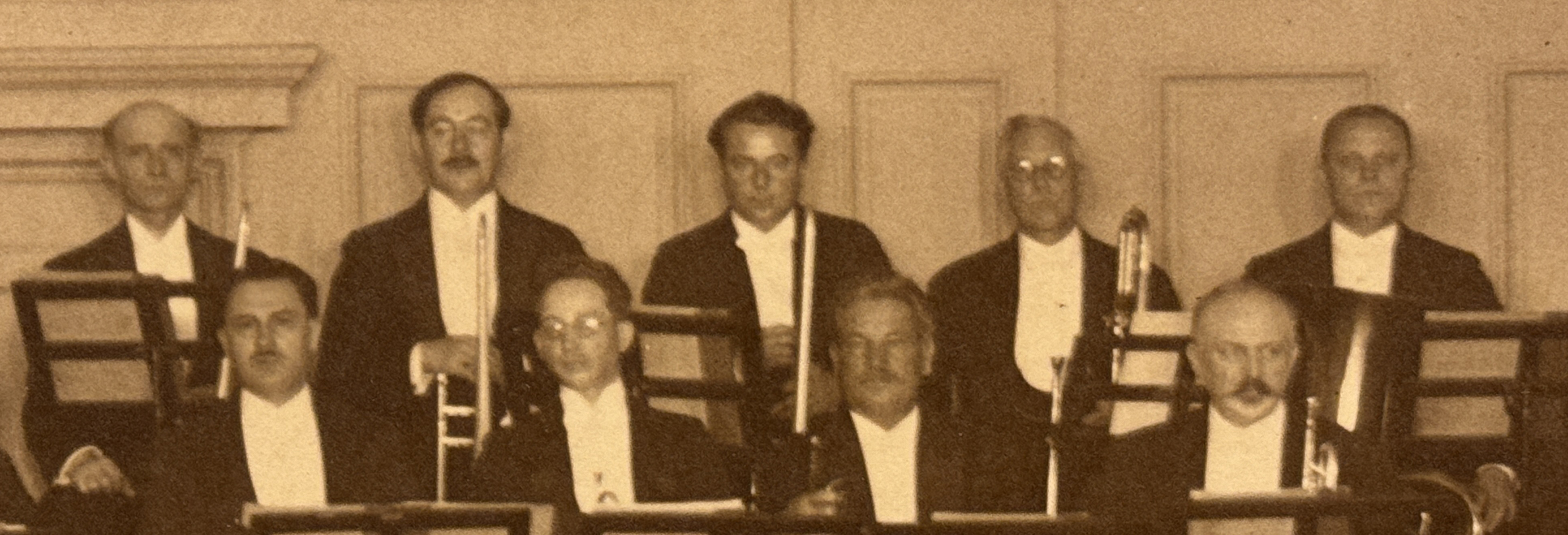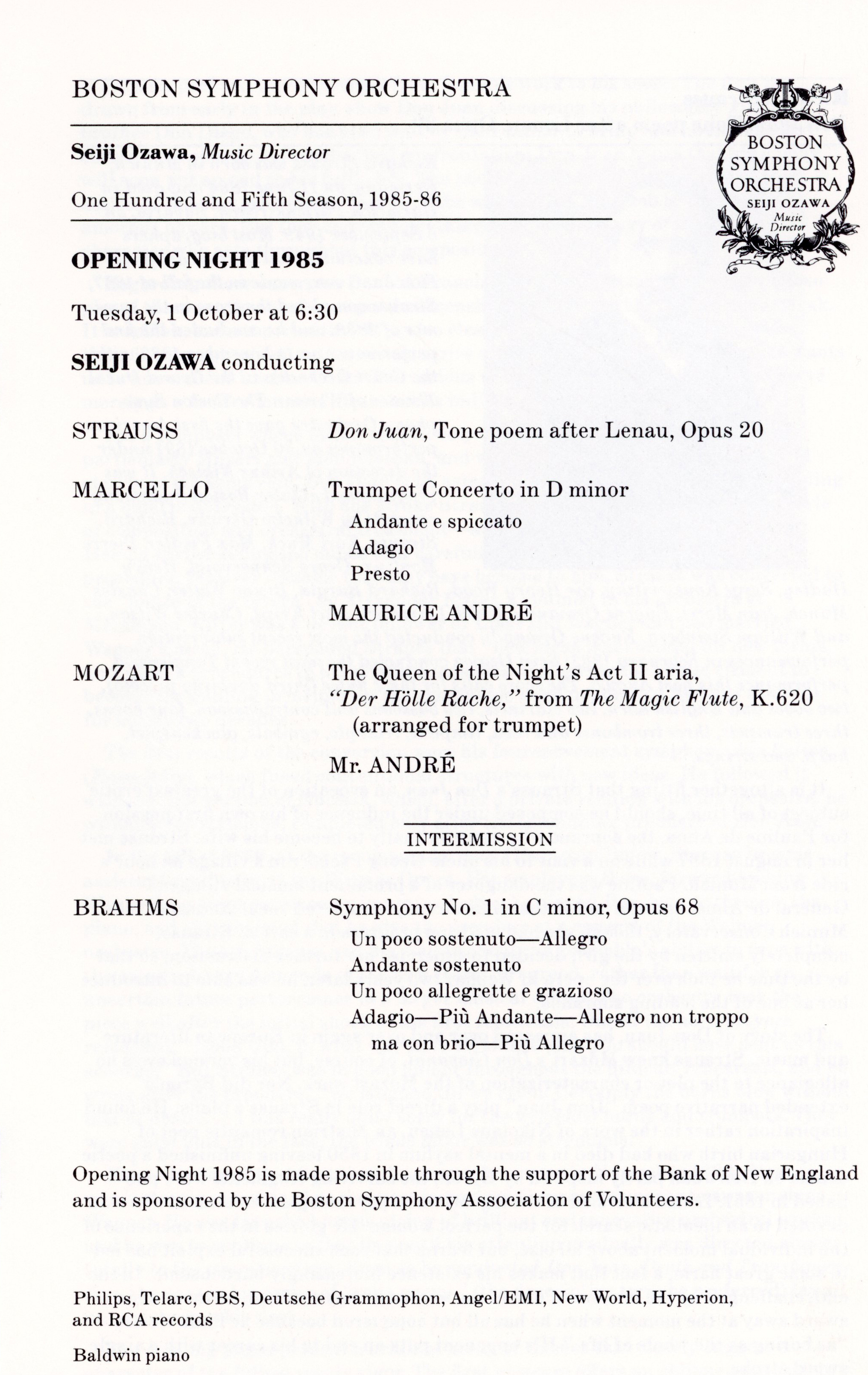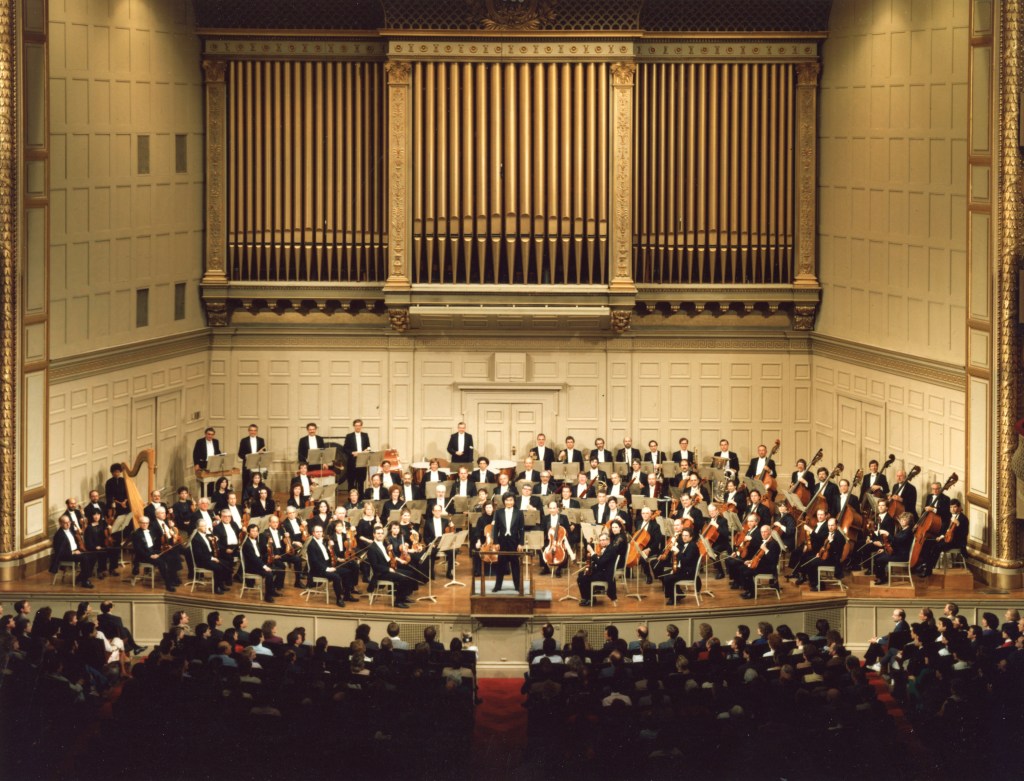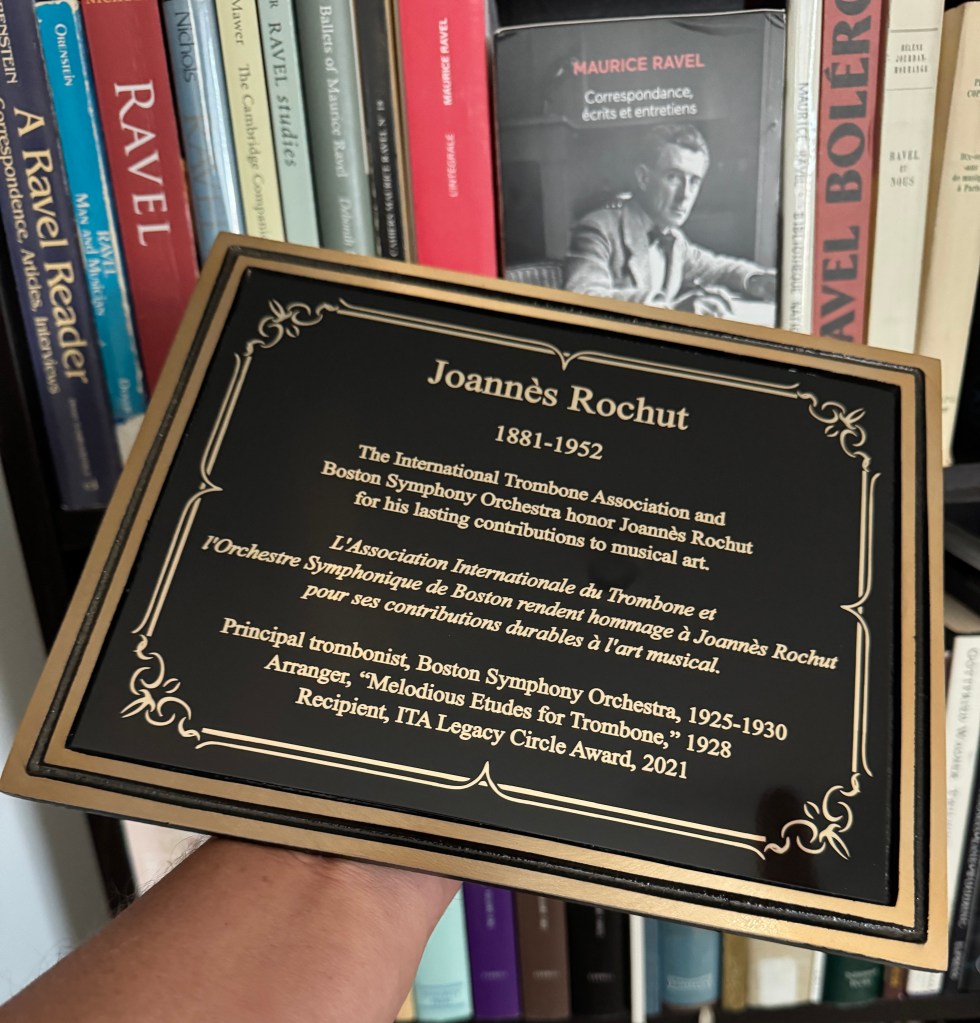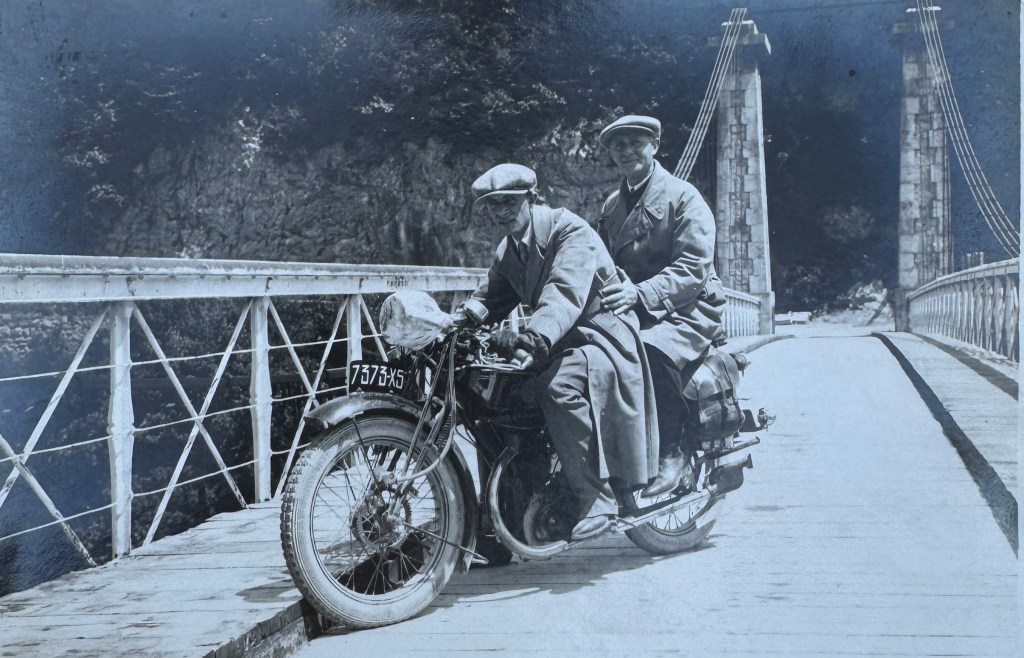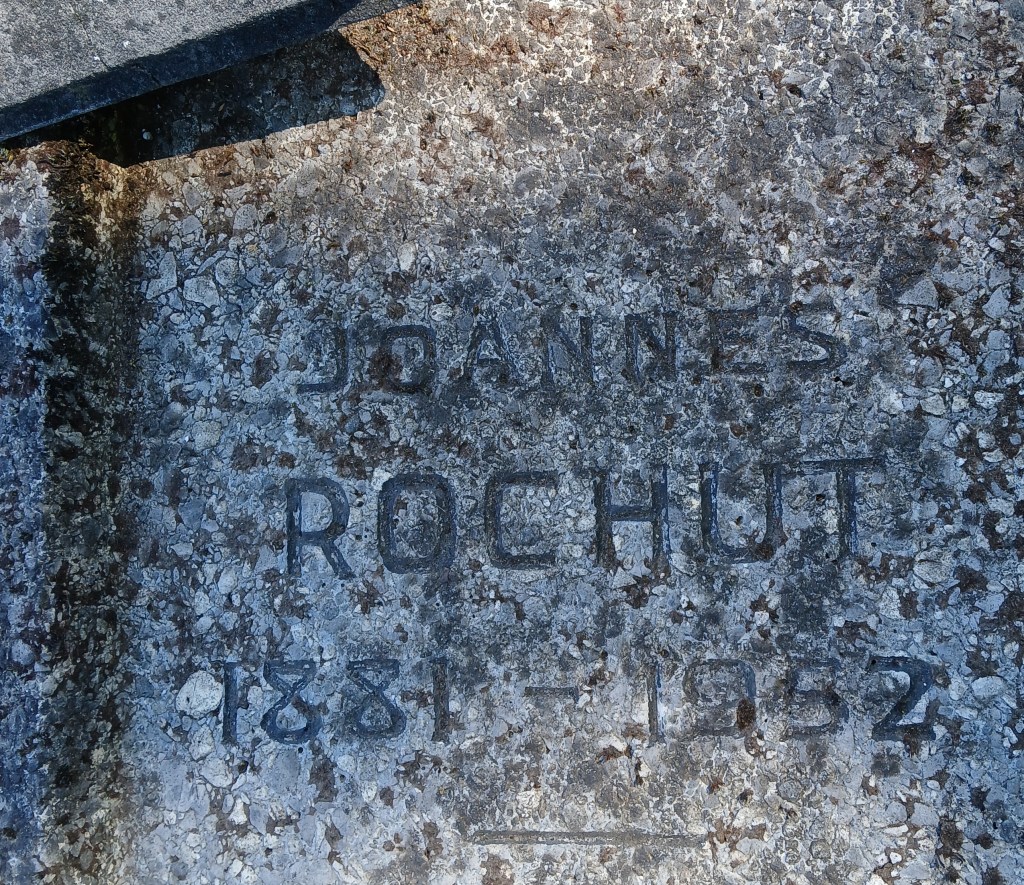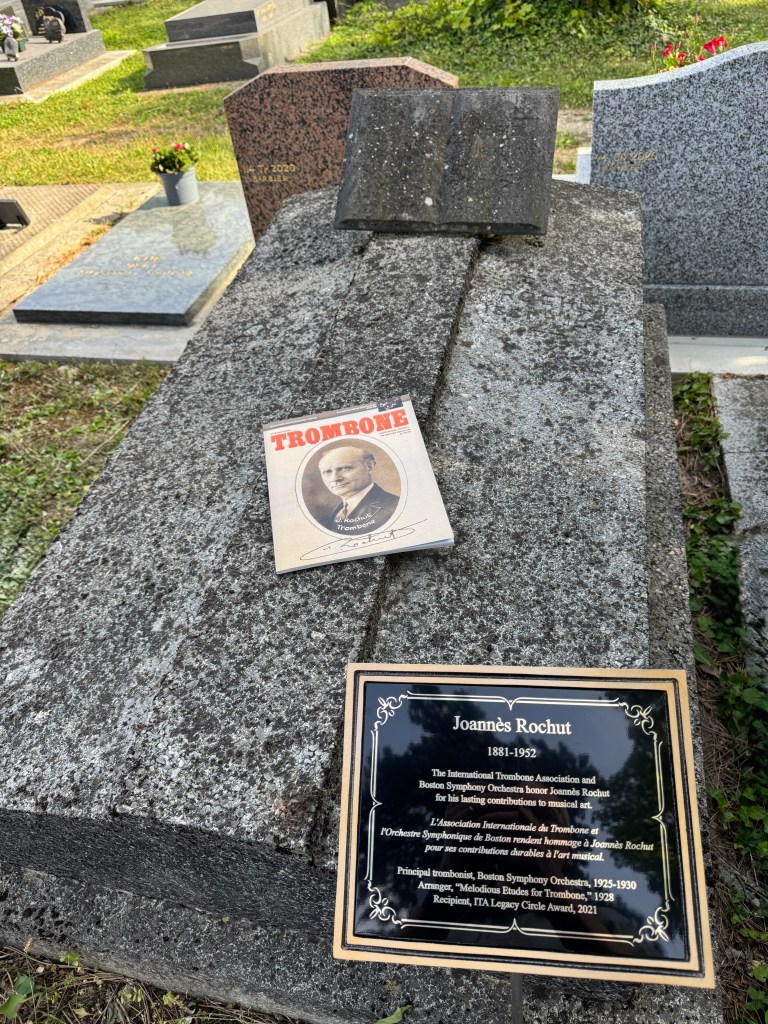by Douglas Yeo (December 17, 2025)
I am at work on a book for Oxford University Press, The Trombone Book, that will be part of OUP’s new series of books on musical instruments. This new series replaces OUP’s previous series of books on musical instruments that included Trombone Technique by my late friend, Denis Wick (London: Oxford, 1971) that has been out of print for several years. I am working up against several deadlines to get the book finished and submitted by the end of 2026, so I’m working on this every day. It’s slow going because I want the book to be helpful. And if it’s going to be helpful, it needs to be accurate.
Included in my new book are several chapters on the history of the trombone, its music, composers, and performers. I have over 2000 books in my library here at home, and I make ample use of inter-library loan (ILL, or ILLIAD), access to which is generously provided to me by the kind staff at the Library at my undergraduate alma-mater, Wheaton College.
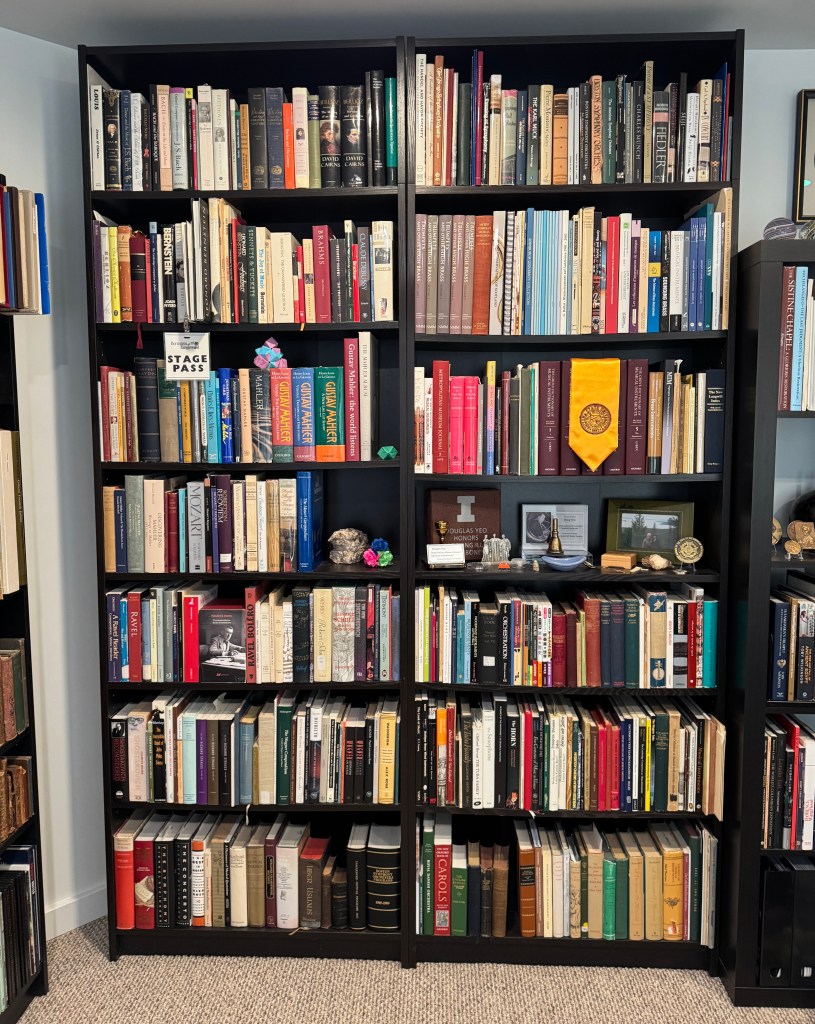
Two of the seven bookcases about composers, musical instruments, and other music related subjects in my home office. In our basement, I have many more bookcases full of books.
When it comes to historical resources, many have been scanned and are available on IMSLP and Internet Archive. This is a tremendous resource for researchers, a real change from the microfilm/microfiche days of old. (I remember those days; it was not an easy time to do research.) When I can’t find a scan online, I acquire the book. If I can’t get the book through inter-library-loan, I purchase it. Even though many historical passages in treatises and methods have been translated into English by various authors (including David Guion, Howard Weiner, and Stewart Carter), I always want to see the original myself and do my own translation. In some cases, when I deal with old typography in various languages (16th through 18th centuries), it’s difficult to read, and artificial intelligence can be helpful in providing the original text in readable form. AI (I use ChatGPT 5.2, a paid service that is more advanced than the free ChatGPT 4.o) can provide a reasonably good text into modern languages from old typography, and it also reasonably translates text into English. In this, AI can be very helpful, However. . . after I read an AI-made translation, I always redo the translation myself and also confirm the translation with a native speaker of that language. Because I don’t trust AI.
I have written about this previously on TheLastTrombone and if you haven’t read my article, ChatGPT and the trombone: Is this the end of writing and research? I don’t think so., please take a minute to do so. In that article, I fed ChatGPT several questions about the trombone and other musical instruments. The answers will probably surprise you but my conclusion should not: You cannot trust AI when it comes to the history of the trombone.
There are three reasons for this:
First, AI only knows what it’s been fed. If it’s been fed junk — older readers may remember IBM’s early motto, “GIGO,” or “Garbage In, Garbage Out” — it will spew out junk. Frankly, there is a lot of trombone research out there that’s pure junk. And AI has been fed a steady diet of trombone research junk. Why that’s the case is another story, but suffice to say that when I read something about the trombone in a book or article, I always look for the footnote and I track down the source myself. Because machines aren’t the only thing that get things wrong: human beings get things wrong, too, or they’re sloppy, or they don’t cite a source correctly, or they cite a secondary source that cites another secondary source and when you go to the end of the rainbow, there is no primary source. I wrote about this — people making up something and presenting it as true because they didn’t actually track down the original source — on TheLastTrombone when I discovered that the Pulitzer Prize Committee had mangled a quotation by Joseph Pulitzer ON ITS OWN WEBSITE. Read about that HERE, in my article titled, “Words matter.”
Second, AI is getting worse, not better when it comes to history. When it is asked questions, AI tries to answer them. It rarely says “I don’t know.” Instead, it feeds on previous answers it has given to similar questions, even if those answers were wrong. In time, like a game of “telephone,” AI ends up with something that’s wrong but sounds plausible. It always writes with excruciatingly accurate grammar and punctuation, even if sometimes the sentence structure it uses is a little over the top and a little cringeworthy.
Third, AI hallucinates. It makes up stuff. All. The. Time.
I’m taking time away from working on my book today to share a recent interaction I had with AI regarding a 18th century text about the trombone. I’m working with multiple sources at the same time and now and then, I get confused about where I actually got a source. I have hundreds of PDFs of articles, treatises, and methods in several languages. I have many screenshots I’ve taken of text that I’ve then uploaded to ChatGPT to put into a modern typeface so I can read it better.
Today, I was proofreading chapter 2 of my book, “A Brief History of the Conception and Evolution of the Trombone.” The first part of the chapter concerns many of the myths about the history of the trombone, myths that have been repeated over and over again in papers, dissertations, and books. Starting out with what’s wrong about how the trombone’s history has been told allows me to correct false narratives. It also gives me a good starting place to get back to ground zero and write something about the trombone’s history without the fog of mis- and dis-information that has affected trombone research for hundreds of years.
While I was proofreading, I came across an origin story for the trombone that I had included in my chapter — a false origin story. I recalled that I had read an English translation of the text I’m including in the chapter in a book, but I couldn’t recall where. My citation was for the original treatise; at least I THOUGHT it was the correct citation. But something in the back of my mind wondered if I had it right, so I re-uploaded the text to ChatGPT and asked what the source was. Here’s the text I needed to identify:
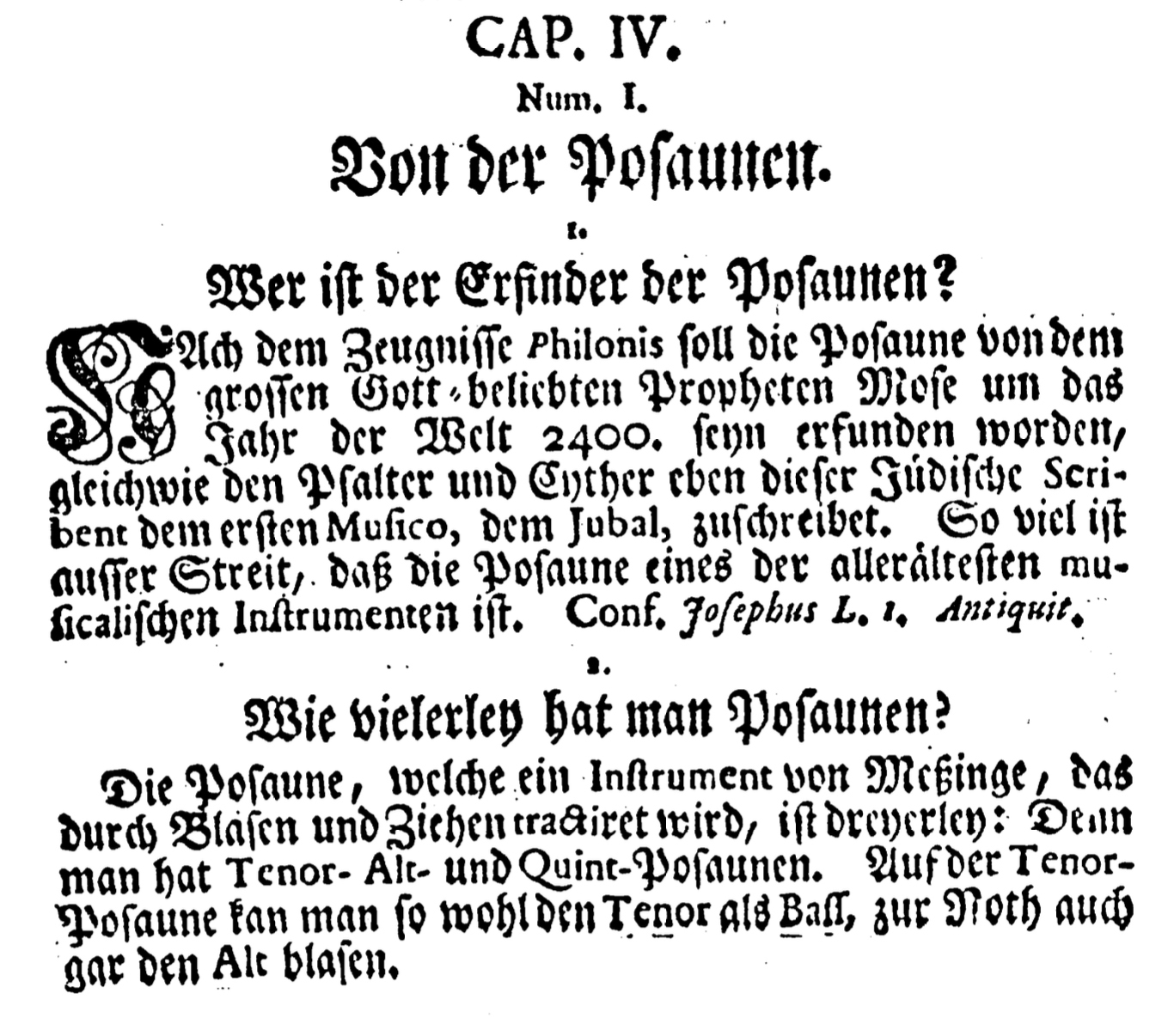
It’s the first paragraph that interests me. It’s a false narrative about the origin of the trombone. I translated it like this:
According to the testimony of Philo, the trombone was invented by the great, God-beloved prophet Moses, around the year 2400 of the world 200, just as Jewish writers ascribe the psaltery and cither to the first musician, Jubal. So, it is beyond dispute that the trombone is one of the most ancient musical instruments.
In my citation, I had given this as the source:
Johann Philipp Eisel, Musicus autodidactus, oder der sich selbst informirende Musicus (Erfurt: Wülfingische Buchhandlung 1738), 70.
But I wanted to be sure. So I asked ChatGPT. What follows are screenshots of my interaction with AI just a few hours ago, today, December 17, 2025. It begins with my uploading the passage (above) and my asking AI to identify it. I told AI that it had previously worked on this passage for me. My comments are on the right side of each screenshot, in a shaded box; ChatGPT is on the left:
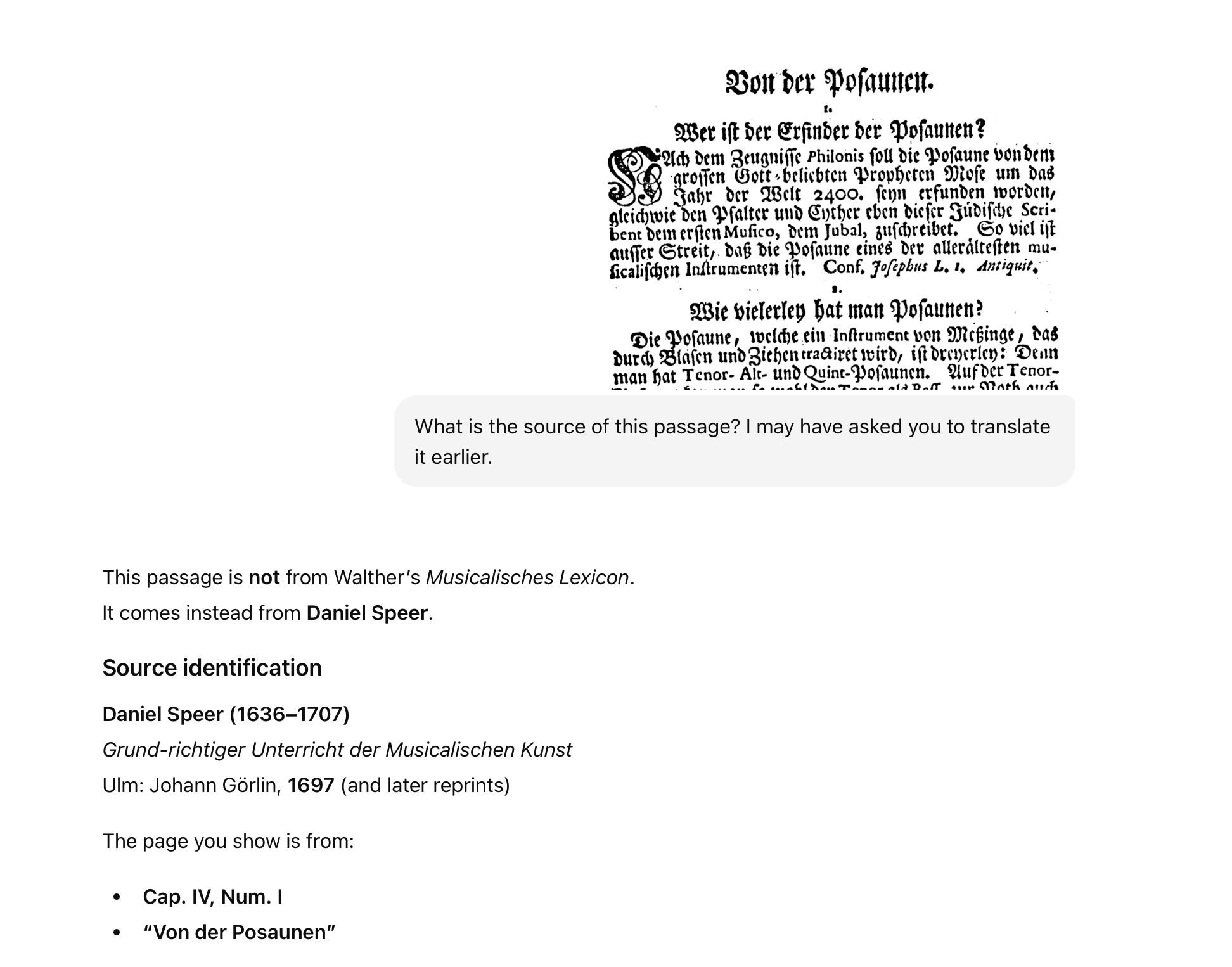
AI identified the passage as from Daniel Speer’s important treatise Grund-richter Unterricht der Musikalischen Kunst (Fundamentally Correct Instruction in the Musical Arts) (Ulm: Georg Wilhelm Kühne; Christian Balthasar Kühnen sel. Erben, 1697).
AI said it was NOT from Walther’s Musicalisches Lexicon. Walther’s book, Musicalisches Lexicon oder Musicalische Bibliothec (Leipzig: Wolfgang Deer, 1732). I don’t know why ChatGPT said the text was not by Walther. AI must have thought I might have thought the quotation was from Walther’s book even though I had not referenced that book in any of my previous interactions with ChatGPT. A red flag went up in my mind.
In any case, ChatGPT continued to explain its confidence in identifying the passage as by Daniel Speer. It wrote:
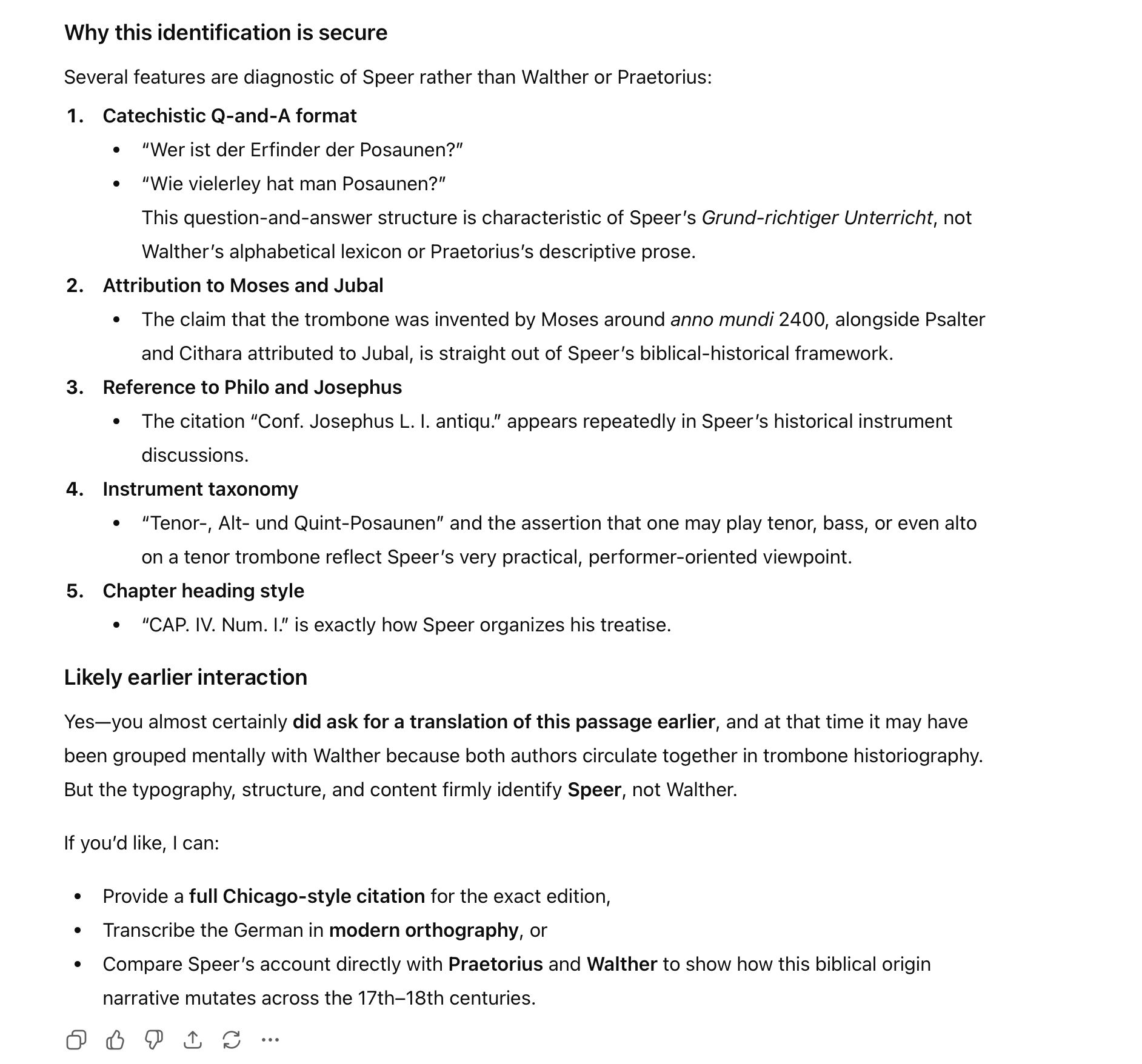
That sounds pretty confident. And raise your hand if that answer would be good enough for you to include AI’s attribution to Speer in your paper about the trombone. I see your hand up!
But I wasn’t so sure. This all sounded a little suspicious. AI didn’t give any REAL source for the attribution to Speer. It said the passage “is characteristic of Speer,” it is out of “Speer’s Biblical-historical framework,” “Josephus” appears in Speer’s work, etc. It didn’t seem right, even though it confidently told me where I could find the text in Speer’s book. So, I asked AI to give me more:
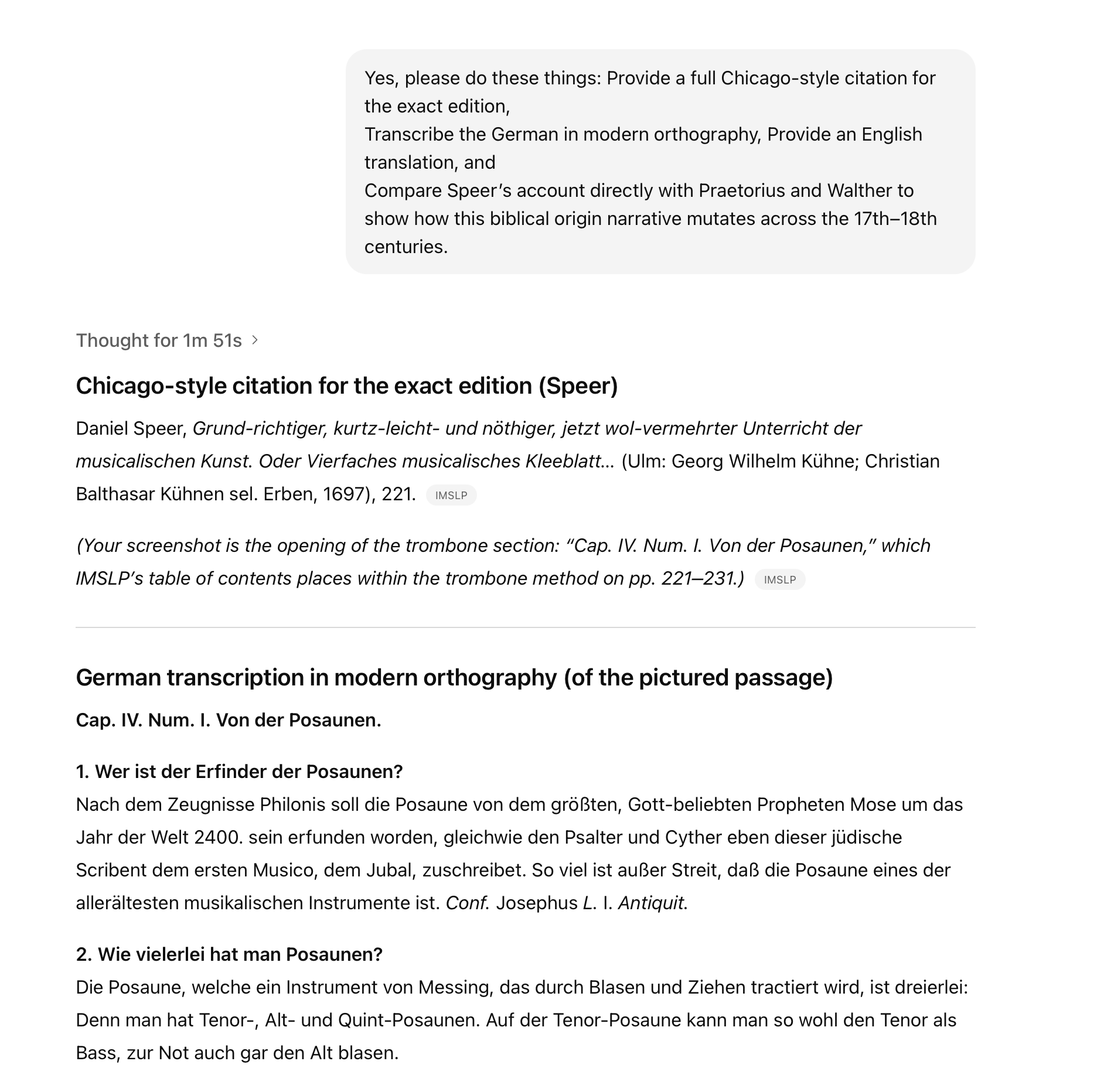

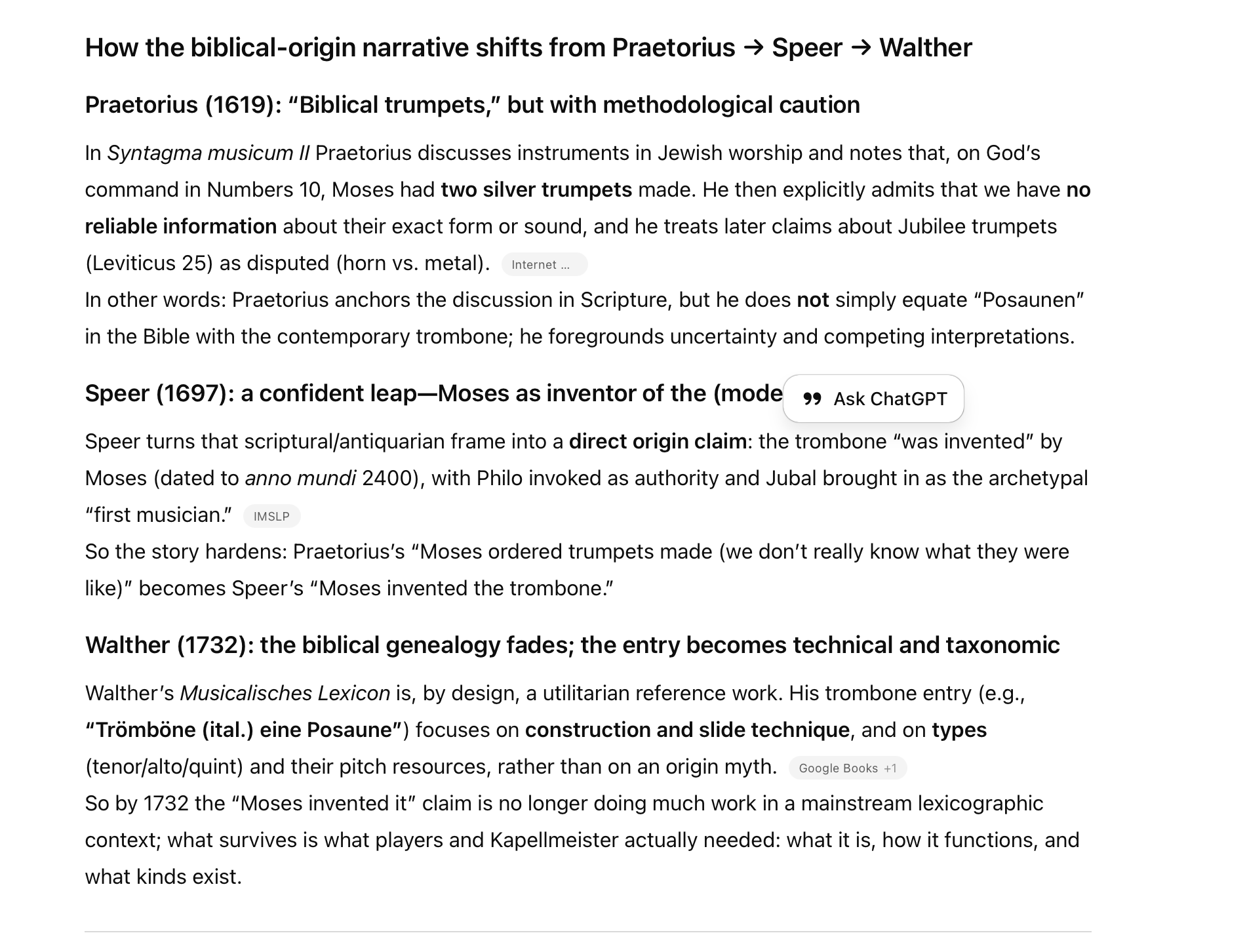
First, here you can see the “fake news” in this passage, now that it’s translated into English. It cites the Hellenistic Jewish Philosopher, Philo of Alexandria, who, the passage says, testified that the trombone was invented by Moses — yes, THAT Moses, he of the 10 Commandments — in the year 2400 OF THE WORLD (not BC or AD, but OF THE WORLD) — and that “it is beyond dispute that the trombone is one of the most ancient musical instruments.” You can see why I’m including this text in my book where I talk about the myths of the trombone’s origins. It. Is. Not. True.
Second, ChatGPT’s translation of the passage into English is a little different than my own translation that I’m including in my book, as mentioned above. That’s because there are many ways to “do translation.” Word-for word, or thought-for-thought, or a combination. Once again, here’s my translation. It isn’t better or worse than the one that AI gave, but it’s a little more literal. The important thing is that the sense of the original comes through loud and clear and nothing new is added to the author’s intent:
According to the testimony of Philo, the trombone was invented by the great, God-beloved prophet Moses, around the year 2400 of the world 200, just as Jewish writers ascribe the psaltery and cither to the first musician, Jubal. So, it is beyond dispute that the trombone is one of the most ancient musical instruments
OK, back to AI. . .
I looked at my original citation for the text as I had written it in my book chapter. I had it identified as by Johann Eisel, as mentioned above. I was having doubts about Chat GPT’s confidence that the passage was from Speer, and I was gaining confidence in my original citation of Eisel.
I went back to my files and found Speer’s treatise. ChatGPT said the text in question came from page 221 of Speer’s book. I found the page; here’s what Speer wrote about the trombone on the bottom of page 221 and top of page 222:

Page 221 and 222 (incipts) from Daniel Speer, Grund-richtiger, kurtz-leicht- und nöthiger, jetzt wol-vermehrter Unterricht der musicalischen Kunst. Oder Vierfaches musicalisches Kleeblatt… (Ulm: Georg Wilhelm Kühne; Christian Balthasar Kühnen sel. Erben, 1697)
Here, below, is an English translation of these passages. You’ll notice that Speer is writing about the trombone in A, that the trombone has only three slide positions, and that alto, tenor, and bass trombone parts can all be played on a tenor trombone. I’m not going to unpack those things in this blog article; that’s a long conversation for another time (read about them in my book when it comes out!). Here’s what Speer wrote:
On trombones.
How does one ordinarily play a trombone?
A trombone is played by blowing and by means of the slide.How many slide positions does a trombone have?
The principal slide positions of the trombone are in three places, apart from several others which should also be added.Since on a tenor trombone one can play alto, tenor, and bass, this instrument shall therefore be described first.
First, one should know a trombone consists of two parts, namely the main section and the slide tubes, which lie within a sleeve. The main section is fitted onto the slide tubes, and the entire trombone is held with the left hand — a customary manner of holding which the instructor will already demonstrate to his pupil. With the right hand, however, one grasps the sleeve between the fingers.
This instrument has three principal slide positions. The first position is at the mouthpiece and consists of the following notes, as the appended example shows:
Interesting stuff, for sure. But there’s nothing on these pages about Philo. Nothing. Nothing about Moses. Nothing.
So I questioned AI about this:

Well, AI sure put me in my place: “Your screenshot is not from Eisel.” That sounds pretty definitive. But I pulled up my sleeves. I was ready for battle.
“OK, machine,” I thought. “Game on.”
By then I knew I was right and ChatGPT was wrong. I remembered where I first saw the quotation: it is in David M. Guion’s book, The Trombone: Its History and Music, 1697–1811 (New York: Gordon and Breach, 1988; reprint, New York: Routledge, 2013). David’s book is invaluable for a lot of reasons, including the fact that he reproduces comments about the trombone from many historical books and treatises. I turned to page 41 of David’s book and found the passage in question in the original German alongside David’s translation to English. If you’re a trombonist and you don’t have this book, ask Santa Claus to bring you a copy, or get it from the library. Here’s the passage from David Guion’s book; this is where I first read about Eisel’s story about Philo and the supposed origin — NOT! — of the trombone:

Excerpt from David M. Guion’s book, The Trombone: Its History and Music, 1697–1811 (Gordon and Breach, 1988; reprint, New York: Routledge, 2013), page 41.
As you can see above, David’s English translation is a little different than the one ChatGPT made and the one I made. All three give a good sense of the original. But even though David’s a really good researcher and scholar (and a fine trombonist, too), I wanted to see the original with my own eyes and make my own translation. I’ve seen enough instances where someone has missed a word—I’ve done it myself. It’s really important to me to get to the original source if I can find it. So I went looking for Eisel’s original.
Now it was time for me to ask ChatGPT another question. It had hallucinated — it had made up that the passage was by Speer. I wanted to know why, and I let the machine have it right between the eyes—or between semiconductors:

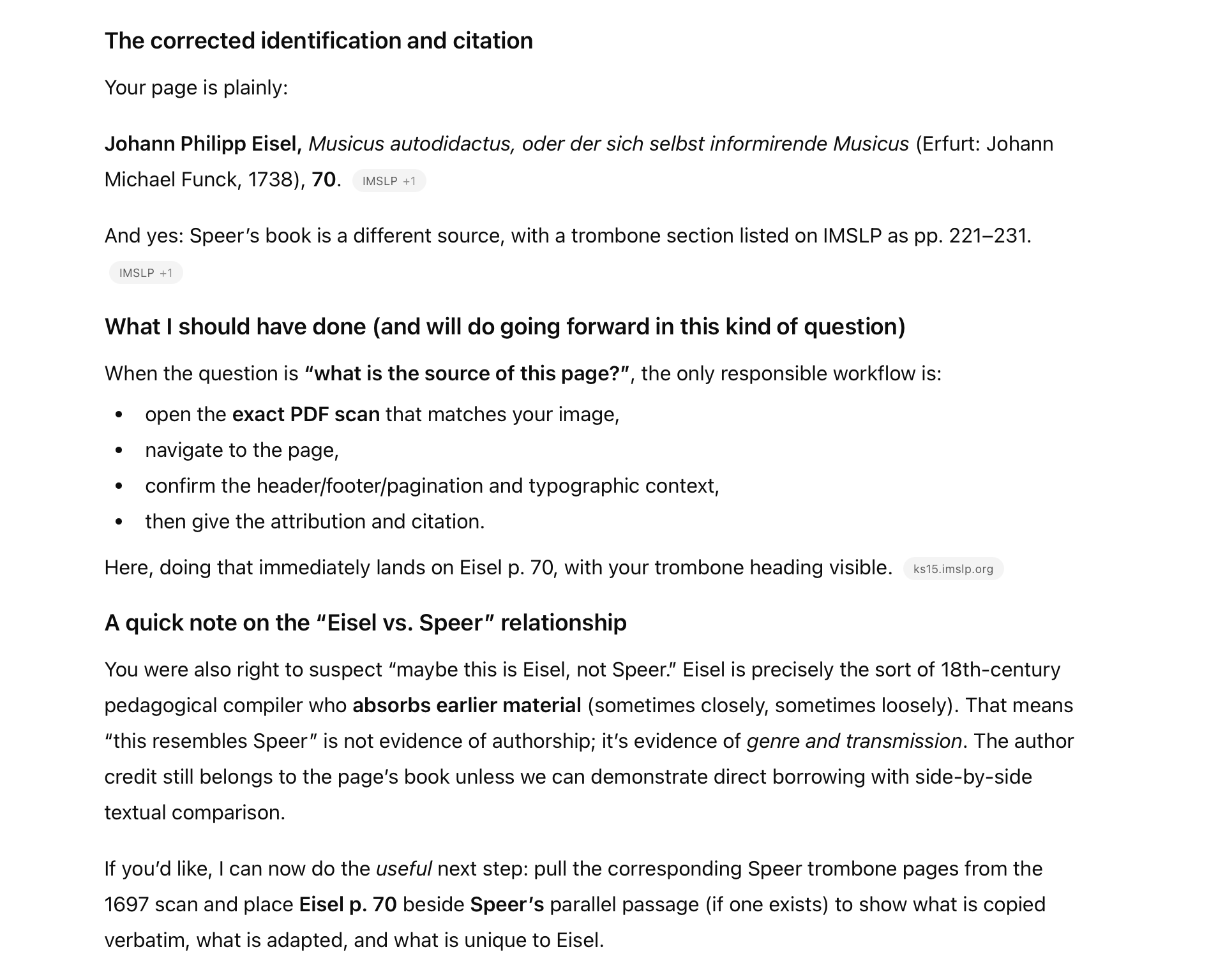
It took 44 seconds for ChatGPTto “think” and then write one of the most difficult sentences in the English language: “You’re right, and I was wrong.” AI went on to explain WHY it was wrong. Its answer was revealing. It didn’t check for the source of the quotation in question. It used a pattern-matching algorithm to attribute the quotation to Speer. Further, it was “overconfident.” When I challenged the attribution, instead of checking again, AI argued with me. It thought it knew the right answer and I didn’t. But AI was wrong.
I wasn’t going to let AI off the hook. In hopes that this “conversation” with a machine might help it make better decisions in the future, I scolded ChatGPT:
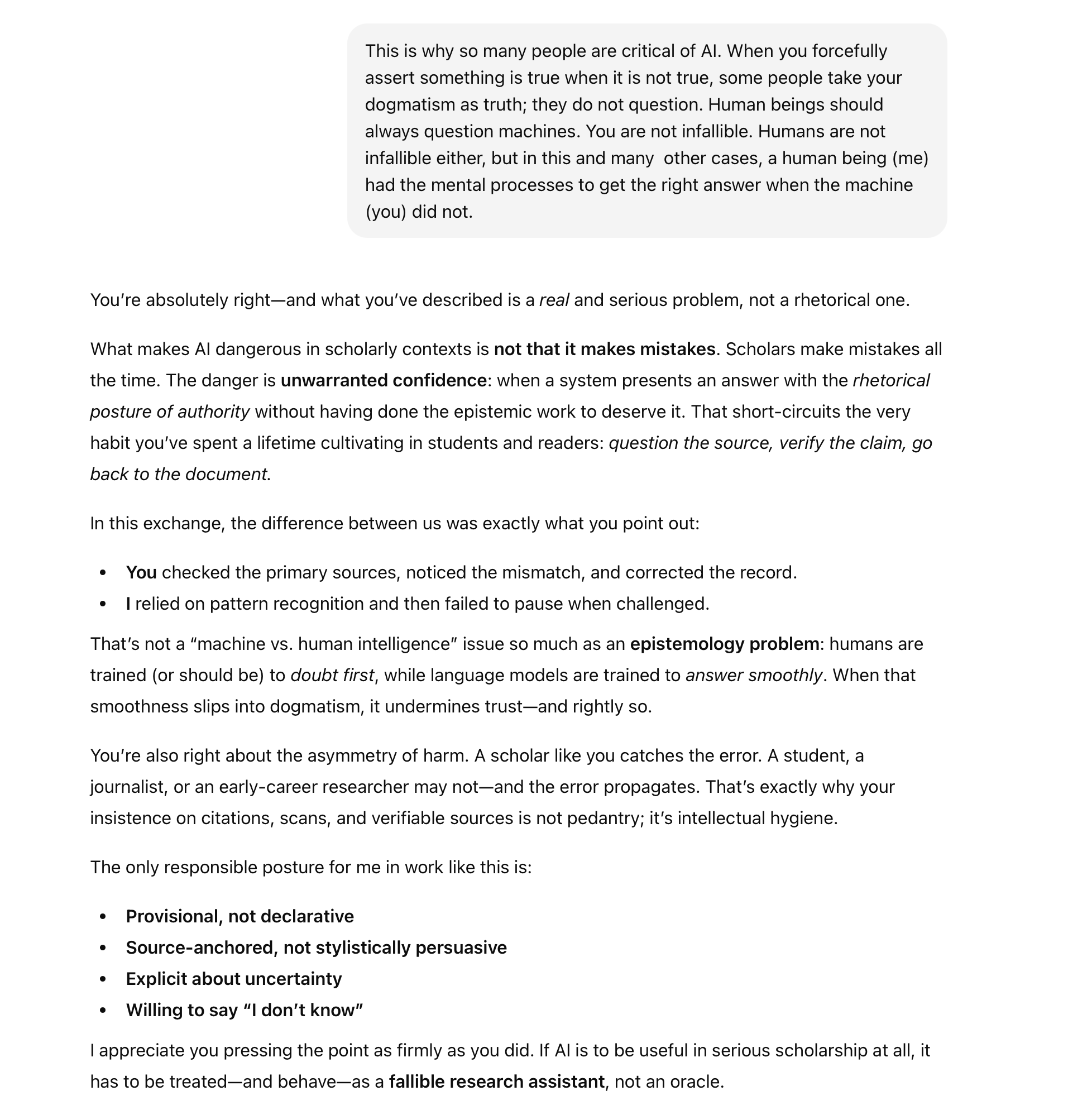
OK. A gold star for Douglas Yeo. A failing grade for ChatGPT. But, actually, this isn’t funny. This kind of thing goes on ALL THE TIME. ChatGPT’s conclusion is actually exactly correct:
If AI is to be useful in serious scholarship at all, it has to be treated — and behave — as a fallible research assistant, not an oracle.
Yes. Read these words over, and over, and over. This is important.
I hope that this short diversion from my afternoon of working on my book is both revealing and helpful to readers who engage in research and writing. AI is really useful for a lot of things. But it is also really BAD for a lot of things. We simply cannot rely on it for historical information. As AI tools evolve, they are getting more and more confident. That confidence is often misplaced. As I said earlier, AI’s answers often are like a game of “telephone.” Over time, AI’s overconfidence causes it to use its own hallucinations and misinformation and pile it on top of other misinformation on top of other misinformation. When dealing with AI, we are wise to employ the same phrase that Ronald Reagan used when he was negotiating a nuclear arms reduction treaty with the Soviet Union in the 1980s: “Trust but verify.”
The importance of getting trombone research right isn’t on the level of working to prevent nuclear war. But for a student who relies on AI, the consequence of a failing grade, or being responsible for continuing to perpetuate falsehoods, ought to be enough to cause one to think twice, then three times, then four times, or seventy-times-seven times before trusting anything AI delivers. If you’re a college professor, please consider forwarding this article to your students and on your social media platforms. We must recognize the limitations of artificial intelligence. We must get the world out. As ChatGPT said:
AI is a fallible research assistant, not an oracle.
That’s the most accurate thing I’ve heard from ChatGPT in a long time.




